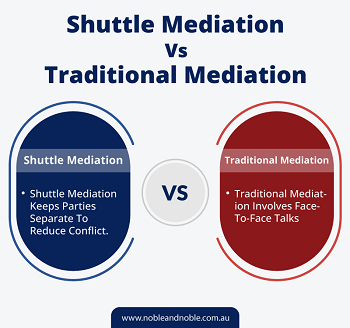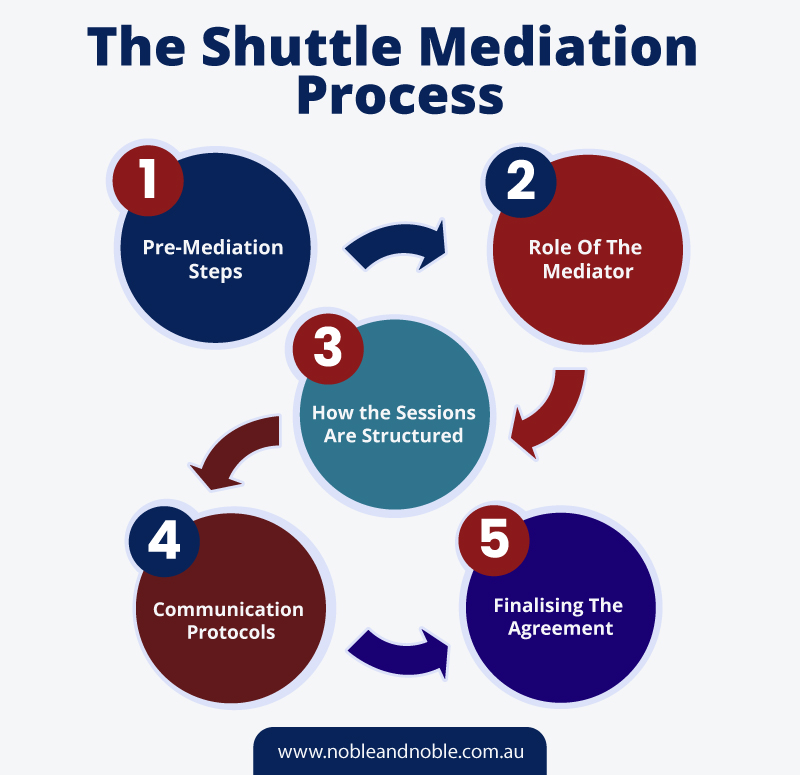
Shuttle Mediation Process in Australia – Complete Guide
Table of Contents
Shuttle Mediation Process in Australia
Shuttle mediation is an alternative dispute resolution method gaining popularity in Australia, particularly in 2024. Unlike traditional mediation, where all parties meet together, shuttle mediation involves the mediator moving back and forth between the parties, who remain in separate rooms. This process is especially useful in high-conflict situations where direct communication may not be possible or productive.
In this comprehensive guide, we will explore the shuttle mediation process in detail, covering everything from its legal framework in Australia to practical tips for participants. Whether you are a legal professional, a mediator, or someone considering mediation for a dispute, this guide will provide you with the knowledge you need to navigate shuttle mediation effectively.
What is Shuttle Mediation?
Shuttle mediation is a form of dispute resolution where the mediator facilitates negotiations between parties who are not in the same room. The mediator “shuttles” between them, conveying offers, counteroffers, and messages. This approach can reduce tension and allow for a more controlled negotiation environment, particularly in cases where emotions run high.
Differences Between Shuttle Mediation and Traditional Mediation

Traditional mediation involves all parties meeting together in the same room, with the mediator facilitating the discussion to help reach an agreement. This method encourages direct communication and collaboration between the parties involved.
Shuttle mediation, on the other hand, keeps the parties in separate rooms, with the mediator moving between them to convey messages and proposals. This approach can reduce tension and conflict, creating a more structured and less confrontational environment for negotiations.
Benefits and Drawbacks of Shuttle Mediation
Shuttle mediation offers several benefits, including reducing emotional stress, allowing for private discussions, and creating a more controlled environment.
However, it also has drawbacks, such as potentially longer sessions and the need for a skilled mediator to manage the process effectively. Understanding these pros and cons can help parties decide whether shuttle mediation is the right choice for their situation.
Legal Framework in Australia
Overview of Mediation Laws
Mediation in Australia is governed by a combination of federal and state laws, which provide a framework for how mediation processes should be conducted. These laws ensure that mediation is a fair and equitable process, with specific regulations for different types of disputes, including family law, commercial conflicts, and workplace issues.
Specific Regulations Governing Shuttle Mediation
While shuttle mediation falls under the general mediation laws, there are specific guidelines and best practices that mediators follow to ensure the process is effective. These include rules about confidentiality, the mediator’s neutrality, and the proper conduct of the mediation sessions. In 2024, there have been updates to these regulations to address the growing use of shuttle mediation in various legal contexts.
Recent Changes in 2024
The year 2024 has seen several significant updates to Australia’s mediation laws, particularly concerning shuttle mediation. These changes reflect the increasing demand for this method in resolving disputes, particularly in family law and commercial settings. The new regulations aim to streamline the process, improve outcomes, and ensure that all parties have access to fair mediation.
When to Use Shuttle Mediation
Common Situations Where Shuttle Mediation is Beneficial
Shuttle mediation is particularly useful in situations where direct communication between parties is either impossible or undesirable. This includes cases involving high-conflict divorces, disputes with significant power imbalances, or situations where one party feels threatened by the other. By keeping the parties apart, shuttle mediation can help to create a safer and more productive negotiation environment.
Family Law Disputes
In family law, shuttle mediation is often used in divorce or child custody cases where emotions run high. The process allows both parties to communicate their needs and concerns without the stress of direct confrontation, making it easier to reach a fair agreement.
Commercial Disputes
Shuttle mediation is also effective in resolving commercial disputes, particularly when there are complex issues at stake or when relationships between the parties have deteriorated. By separating the parties, the mediator can help to focus on the issues at hand and work towards a mutually acceptable resolution.
Workplace Conflicts
In the workplace, shuttle mediation can be used to address conflicts between employees or between employees and management. This method is particularly useful in cases where ongoing relationships need to be preserved, as it allows for a resolution without direct confrontation.
The Shuttle Mediation Process

Pre-Mediation Steps
Pre-Mediation Steps
Before shuttle mediation begins, several steps need to be taken. These include selecting a mediator, preparing a mediation agreement, and gathering necessary documentation. The mediator will also conduct pre-mediation interviews with each party to understand their concerns and objectives.
Role of the Mediator
The mediator plays a crucial role in shuttle mediation, acting as an impartial facilitator who helps the parties communicate and negotiate. The mediator’s responsibilities include ensuring that the process is fair, managing the flow of information between the parties, and helping to craft a mutually acceptable agreement.
How the Sessions Are Structured
Shuttle mediation sessions typically follow a structured format. Each party will have private meetings with the mediator, during which they can express their concerns and make offers. The mediator then relays this information to the other party, facilitating a back-and-forth negotiation process. This continues until an agreement is reached or the mediation ends without resolution.
Communication Protocols
Effective communication is key to successful shuttle mediation. The mediator must ensure that all communications are clear, concise, and accurately conveyed between the parties. Confidentiality is also critical, as it allows parties to speak freely without fear that their words will be used against them later.
Finalising the Agreement
If the parties reach an agreement, the mediator will help them draft a formal settlement document. This agreement is legally binding and can be enforced by the courts if necessary. If no agreement is reached, the parties may choose to pursue other forms of dispute resolution or take their case to court.
Roles and Responsibilities
Mediator’s Responsibilities
The mediator is responsible for facilitating the mediation process, ensuring fairness, and helping the parties reach a mutually acceptable agreement. This involves managing communication, keeping the parties focused on the issues, and ensuring that the mediation sessions are productive.
Participants’ Roles
The participants in shuttle mediation have a responsibility to engage in the process in good faith. This means being open to negotiation, listening to the mediator, and working towards a fair resolution. Participants should also be prepared to provide all necessary documentation and information to support their case.
Legal Representatives’ Involvement
In some cases, parties may choose to have legal representatives involved in the shuttle mediation process. These representatives can provide legal advice, help to draft the settlement agreement, and ensure that their clients’ rights are protected throughout the process.
Preparing for Shuttle Mediation
What to Expect
Participants in shuttle mediation should be prepared for a process that may take several sessions to complete. The mediator will work with each party separately, which can make the process longer than traditional mediation. However, the separation can also make it easier to reach a fair agreement.
Tips for Effective Preparation
To prepare for shuttle mediation, participants should gather all relevant documentation, think about their goals for the mediation, and be ready to discuss their concerns and interests with the mediator. It can also be helpful to discuss the process with a legal representative or mediator beforehand to ensure that you are fully prepared.
Gathering Necessary Documentation
Having the right documentation is crucial for a successful shuttle mediation. This may include financial records, contracts, emails, or other relevant documents that support your position. Being well-prepared can help to streamline the mediation process and improve your chances of reaching a favourable outcome.
Costs and Fees
Typical Costs of Shuttle Mediation
The costs of shuttle mediation can vary depending on the complexity of the case, the mediator’s fees, and the number of sessions required. Typically, parties can expect to pay between AUD 2,000 and AUD 5,000 for a complete mediation process, although costs can be higher for more complex cases.
Factors Influencing Costs
Several factors can influence the cost of shuttle mediation, including the mediator’s experience, the length of the mediation, and whether legal representatives are involved. It is important to discuss costs upfront with the mediator and ensure that you understand all potential fees before the process begins.
Funding and Legal Aid Options
In some cases, parties may be eligible for legal aid or other funding to help cover the costs of shuttle mediation. This is particularly true in family law cases, where the government may provide assistance to help parties resolve their disputes without going to court.
Expert Insights
Quotes from Leading Mediators in Australia
“Shuttle mediation has become an invaluable tool in the dispute resolution landscape, particularly for cases where direct communication is not feasible.” – Jane Doe, Senior Mediator
“While shuttle mediation can be more time-consuming, the ability to manage high-conflict situations makes it a preferred choice in many cases.” – John Smith, Family Law Mediator
Common Challenges and Solutions
One of the common challenges in shuttle mediation is ensuring that both parties remain engaged in the process, even when they are not directly interacting. Mediators must be skilled in maintaining momentum and keeping the parties focused on reaching an agreement. Another challenge is managing the emotional aspects of the dispute, which can be more pronounced in shuttle mediation. Experienced mediators use techniques such as active listening and reframing to address these challenges.
Practical Tips
How to Get the Most Out of Shuttle Mediation
To make the most of shuttle mediation, it is important to enter the process with an open mind and a willingness to negotiate. Be prepared to listen to the mediator’s advice, consider the other party’s perspective, and focus on finding a mutually acceptable solution. It is also important to stay patient, as shuttle mediation can take time, but the results are often worth the effort.
Avoiding Common Pitfalls
Some common pitfalls in shuttle mediation include becoming too entrenched in your position, refusing to compromise, and not preparing adequately for the sessions. To avoid these issues, it is important to remain flexible, communicate openly with the mediator, and take the time to prepare thoroughly before the mediation begins.
Shuttle mediation is a powerful tool for resolving disputes, particularly in high-conflict situations where direct communication is not feasible. By keeping the parties separated, shuttle mediation allows for a more controlled and focused negotiation process, leading to fair and mutually acceptable outcomes. Whether you are involved in a family law dispute, a commercial conflict, or a workplace issue, shuttle mediation can provide an effective way to resolve your differences without the need for litigation.
Frequently Asked Questions (FAQs)
What is Shuttle Mediation?
Shuttle mediation is a form of mediation where the mediator moves between parties who are in separate rooms, facilitating communication and negotiation.
How is it Different from Traditional Mediation?
Unlike traditional mediation, where all parties meet together, shuttle mediation keeps the parties physically apart, reducing tension and allowing for a more controlled negotiation process.
Is Shuttle Mediation Legally Binding?
If an agreement is reached during shuttle mediation, it can be drafted into a legally binding settlement that is enforceable by the courts.
How Long Does Shuttle Mediation Take?
The length of shuttle mediation can vary depending on the complexity of the case, but it typically requires several sessions to complete.
What Happens if Shuttle Mediation Fails?
If shuttle mediation does not result in an agreement, the parties may choose to pursue other forms of dispute resolution, such as arbitration or litigation.
How Much Does Shuttle Mediation Cost?
The cost of shuttle mediation can vary, but it typically ranges from AUD 2,000 to AUD 5,000, depending on the complexity of the case and the mediator’s fees.
Need Help ?
If you need help, feel free to Contact Us at any time at Noble & Noble Mediations. We have qualified mediators ready to help.
Find Qualified Brisbane Mediators at Noble & Noble Mediations on google maps.




